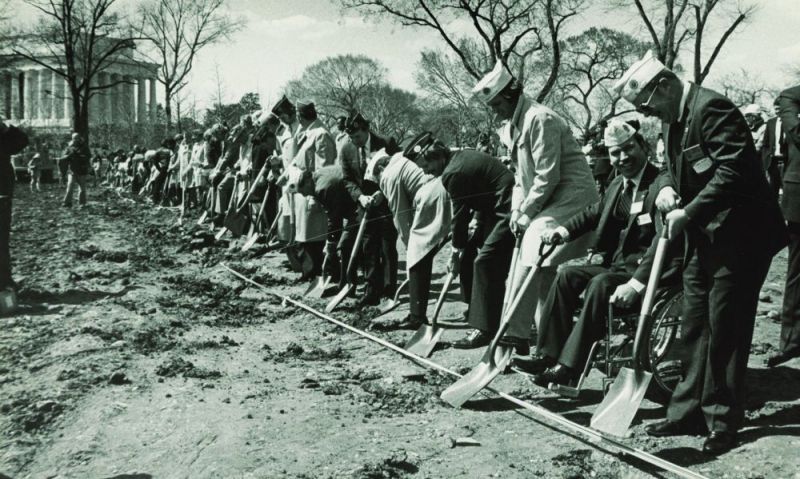.jpg.jpg)
From 1982 to today, the memorial has done what it was designed to do for those who served.
On Nov. 13, 1982, the Vietnam Veterans Memorial was formally dedicated after a process of arguments and compromises that illustrated how a complicated war can spill over into its remembrance. But the priority for The American Legion was the veterans of the war and helping bring about the catharsis that they – and the nation – needed.
Once the project and setting in the National Mall area had been approved, attention turned to the design. The Vietnam Veterans Memorial Fund sponsored a competition that attracted more than 1,420 entries from the United States and abroad. A panel of eight architects and sculptors chose the design of 21-year-old Yale University architecture student Maya Lin – born in Ohio to Chinese-immigrant parents – and the battle was on.
As Lin describes her design on her website: “On seeing the site in Washington, D.C., over Thanksgiving break, I had an impulse to cut open the earth. I imagined cutting into the earth and polishing its open sides, like a geode …. My design evolved into two black granite walls, placed below grade, engraved in chronological order with the names of the men and women who gave their lives in the Vietnam War. At the apex where the two walls join, the dates 1959 and 1973 (marking the beginning and end of the war) ‘meet,’ thus closing the circle of the time span of the war. A veteran can find his or her own time on the wall, and all visitors would be able to see themselves reflected in the names. I wanted the memorial to create a private and personal connection with each viewer to those names.”
This was the choice of the panel, and that was good enough for The American Legion. Ultimately the largest single contributor to the memorial with a total of $1.17 million raised, it was interested more in getting a memorial built than weighing in on aesthetics. To move the process along, the Legion launched a letter-writing campaign to Washington, called a meeting with the Secretary of the Interior and prevailed on the U.S. Commission of Fine Arts, the final authority on the design. The organization continued to throw its weight behind the memorial from the groundbreaking through the 1982 national convention in Chicago, where $1 million of the Legion’s donation was presented, and up to the dedication.
Uppermost in The American Legion’s mind was the warfighters themselves. The Legion sponsored a four-day “National Salute to Vietnam Veterans” around the dedication, which included social events like a party at which, as The Washington Post commented, “Wolfman Jack, the well-known, gravel-voiced disc jockey of the 1950s and 1960s was there along with a handful of Congressional Medal of Honor [recipients], one of whom had a metal hook where his left arm had been. [They] grabbed the mike between songs and shouted to the vets that they were heroes, that this was their week at last, and they responded with shouts and cheers.” There was also a wine-and-cheese reception for the families of POWs and MIAs, and the Legion provided shuttle services to and from area hotels and the National Cathedral, where a 56-hour candlelight vigil and reading of deceased servicemembers’ names was conducted.
According to the American Legion News Service, a lot of the organization’s activity was more nuts-and-bolts: “Thousands of Legionnaires from across the country came individually or in small groups to be part of the historic events, which were characterized in news reports as the real end of America’s longest war and a psychological bridge across the generation gap for the veterans movement. Legion posts in the departments of Maryland and Virginia provided free lodging for some Legionnaires – and non-members – who couldn’t afford Washington hotel rates. Some distant posts and departments sponsored delegations. Hollywood, Calif., Post 43, for example, paid the airfare of two Vietnam veteran members, and the Department of North Dakota sent its State Legion Band. The national organization brought in one Vietnam veteran Legionnaire from every state to coordinate the participation of veterans from his or her part of the country. Headquarters staff members from Indianapolis and Washington manned information booths at four major hotels, guided tours, solved problems and provided service to all comers.”
The dedication came after more than 15,000 Vietnam veterans marched down Constitution Avenue; says the News Service, “teary-eyed well-wishers shouted ‘God bless you, God bless America’ from the sidelines. The American Legion was very visibly represented, with blue caps in every contingent and department colors in most. Disabled Vietnam vet Joe Frank Jr. of St. Louis represented the Legion on the veterans organization float, while the Legion’s own float featured Janice and Brian Welsh, war widow and orphan of Air Force 1st Lt. Richard Welsh. Mrs. Welsh’s letter to The American Legion catalyzed the organization’s involvement with the Vietnam Veterans Memorial as a way to give meaning to all those who died in Vietnam.”
Forty years later, the Wall has been embraced for what it is: a bridge between a difficult war and today, dedicated to those from whom it exacted the ultimate price.
- Honor & Remembrance

